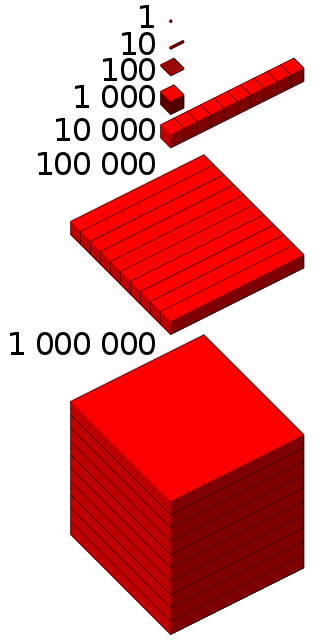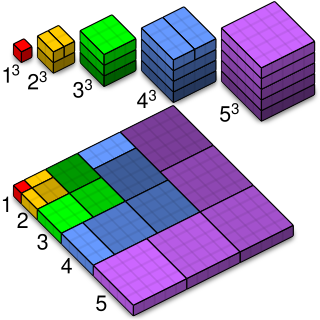
In geometry, a cube is a three-dimensional solid object bounded by six square faces, facets or sides, with three meeting at each vertex. Viewed from a corner it is a hexagon and its net is usually depicted as a cross.

In geometry, straightedge-and-compass construction – also known as ruler-and-compass construction, Euclidean construction, or classical construction – is the construction of lengths, angles, and other geometric figures using only an idealized ruler and a pair of compasses.
Brahmagupta was an Indian mathematician and astronomer. He is the author of two early works on mathematics and astronomy: the Brāhmasphuṭasiddhānta, a theoretical treatise, and the Khaṇḍakhādyaka, a more practical text.
1000 or one thousand is the natural number following 999 and preceding 1001. In most English-speaking countries, it can be written with or without a comma or sometimes a period separating the thousands digit: 1,000.

In arithmetic and algebra, the cube of a number n is its third power, that is, the result of multiplying three instances of n together. The cube of a number or any other mathematical expression is denoted by a superscript 3, for example 23 = 8 or (x + 1)3.
144 is the natural number following 143 and preceding 145. 144 is a dozen dozens, or one gross.
700 is the natural number following 699 and preceding 701.
800 is the natural number following 799 and preceding 801.
2000 is a natural number following 1999 and preceding 2001.
10,000 is the natural number following 9,999 and preceding 10,001.
A cuban prime is a prime number that is also a solution to one of two different specific equations involving differences between third powers of two integers x and y.
8000 is the natural number following 7999 and preceding 8001.
239 is the natural number following 238 and preceding 240.

One million (1,000,000), or one thousand thousand, is the natural number following 999,999 and preceding 1,000,001. The word is derived from the early Italian millione, from mille, "thousand", plus the augmentative suffix -one.

1,000,000,000 is the natural number following 999,999,999 and preceding 1,000,000,001. With a number, "billion" can be abbreviated as b, bil or bn.
216 is the natural number following 215 and preceding 217. It is a cube, and is often called Plato's number, although it is not certain that this is the number intended by Plato.

In number theory, the sum of the first n cubes is the square of the nth triangular number. That is,
271 is the natural number after 270 and before 272.

In arithmetic and algebra the sixth power of a number n is the result of multiplying six instances of n together. So:







